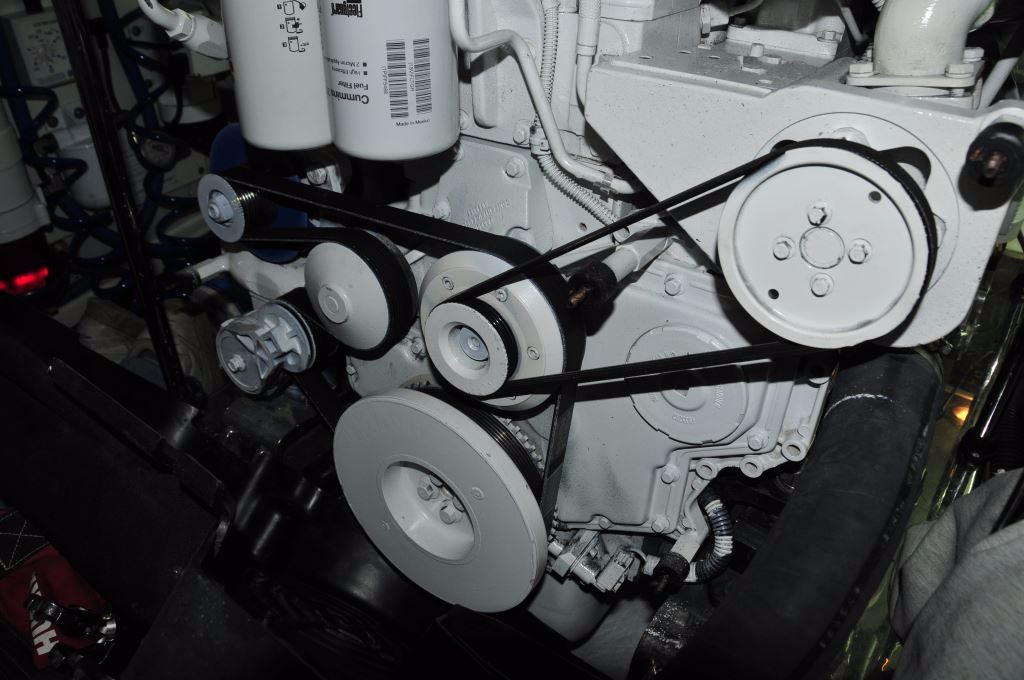Text and photos by Steve D’Antonio
Copyright © 2016
From the Masthead
Have you tasted the tea lately? 
About two years ago, in order to make time zone transition easier, I gave up drinking coffee. I frequently traverse multiple time zones, my record is 27 in ten days, making it challenging to get restful sleep. Sleep experts have noted that caffeine hinders time zone acclimation, and since forgoing it I’m forced to agree. Additionally, it’s tough to get coffee in some places, particularly in China. My morning ritual involved drinking a cup while reviewing e mail. When in Asia I began to find myself fretting the night before about where I would get my cup of joe, and more worrying was the acquisition of milk, which is even more scarce than coffee in China, especially outside of cities. Thus, I’ve taken to drinking decaffeinated tea (I was a tea drinker until getting married, at which point my wife indoctrinated me into the coffee drinkers’ cult), which is easy to carry, and I drink it neat.
In making the change I’ve made an interesting discovery, much of the hot water offered for tea, particularly in the US, has a distinctive stale coffee taste. It simply ruins the tea flavor and is virtually undrinkable. The reason of course is the hot water is dispensed from urns that once contained coffee, thereby tainting the taste of whatever they hold thereafter. What I wonder, however, is how those serving it, in hotels, in flight, at airport lounges and elsewhere, could be unaware of this glaring tea faux pas, unless of course they never taste it themselves, which brings me to the marine industry analogy. When I review invoices prepared by the marine industry, particularly boat yards, I often find myself wondering how they could not know that what they are producing is confusing, incorrect or virtually unintelligible. I also can’t help but wonder if those preparing this material read and critique not only the content but the format as well, which, once again, is often the epitome of illogical and convoluted. To be fair, having worked on boat yard invoice formatting, it’s impossible to please every customer, however, it is possible to clarify and simplify invoices to make them more understandable to the layman. The problem of course is those creating these invoices can’t see the forest for the trees, being so close to it, and knowing subject matter so well, often makes it difficult to recognize the flaws, and of course there’s the natural unwillingness to admit fault if they are responsible for the format’s design.
If you agree, then the next time you receive such an invoice I strongly suggest you share it with the proprietor of the organization responsible for it, let him or her know what you don’t like about it and why, and say, “Imagine if you received an invoice like this from someone you’d hired to undertake a task about which you knew little, roofing or furnace repair for instance, what would your reaction be?”. Figuratively speaking, suggest they take a sip of their own tea.
This month’s Marine Systems Excellence column covers the subject of engine drive belts, I hope you find it both useful and interesting.
Fan Belts
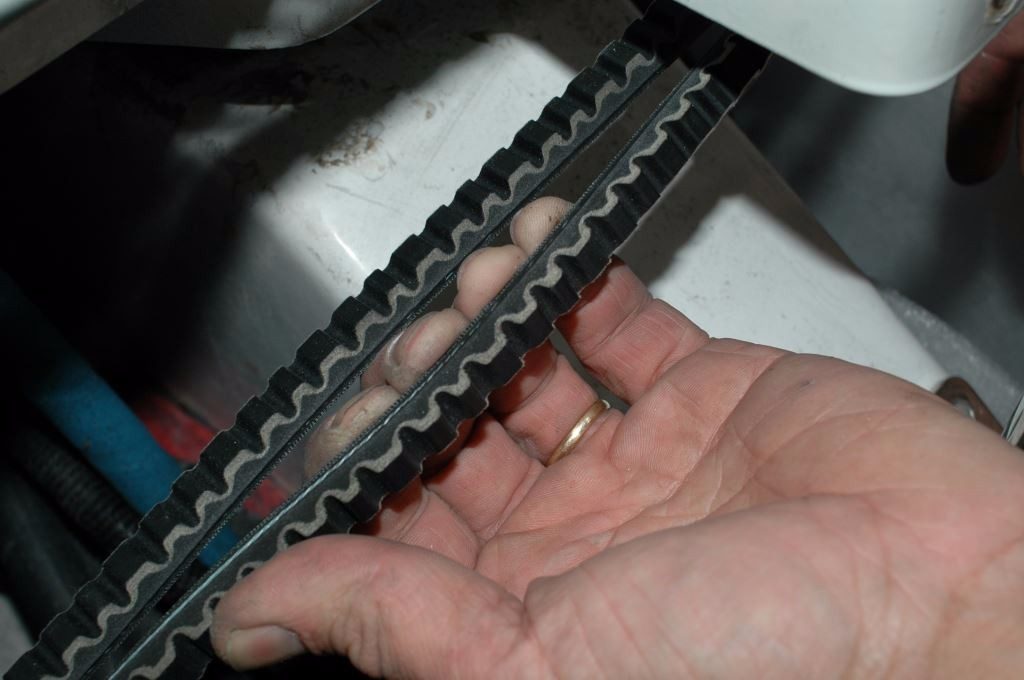
Notched belts are well suited to small diameter pulleys. Using them reduces the likelihood of belt overheating, which is caused by rapid flexing of conventional belts.
The belts that drive an engine’s accessories, which include the raw water pump, circulator pump, and alternator, as well as perhaps a refrigeration compressor and even a hydraulic pump, will typically offer reliable trouble-free service, provided the system is properly designed, and components are maintained, adjusted and replaced before they reach the end of their service life.
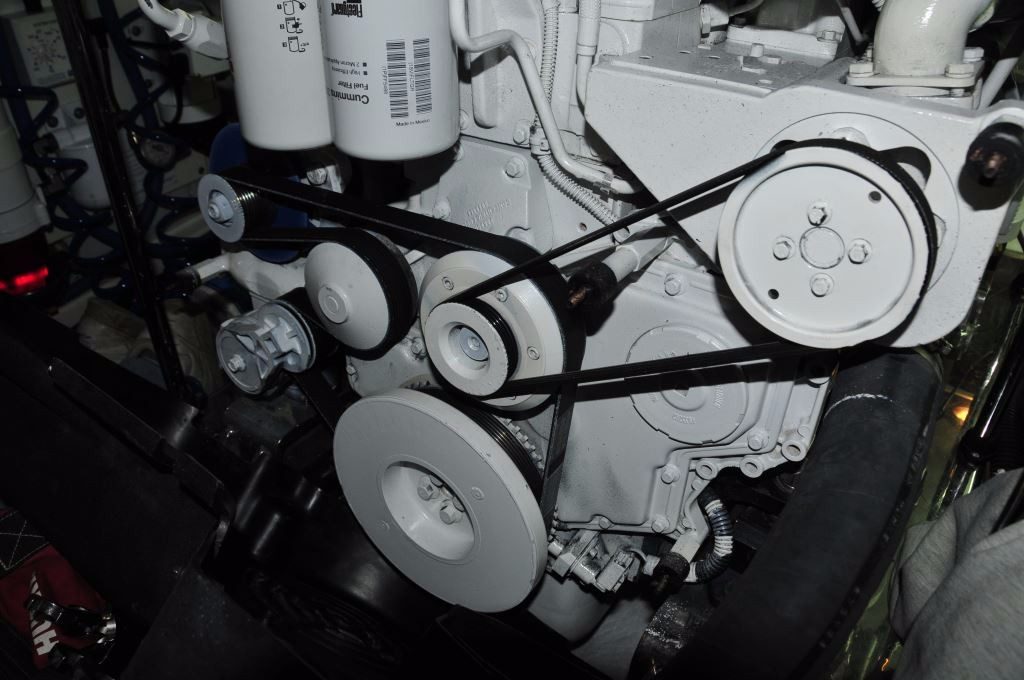
While nearly all belts are installed either by adjusting a driven pulley’s position, an alternator or pump for instance, or by compressing a self-tensioning device, some like the one shown here (upper right) rely on “rolling”, where the belt is simply stretched over a pulley by rotating the latter.
Many vessel operators neglect this all too important component, however, waiting until disaster strikes. Once a belt breaks, all of these vital systems grind to a halt, literally. The raw water pump stops pumping seawater, the circulator pumps stops circulating coolant and the alternator no longer produces electricity. For engines that use multiple belts, the failure of one usually spells the demise of the others, as the flailing deceased belt often entangles with, and takes down, the others in the process. While you may not immediately notice the loss of an alternator, you will very quickly become aware of the loss of seawater and coolant circulation as the temperature gauge climbs into the red, and the overheat alarm sounds (have you confirmed that your coolant high temperature annunciator works, it should sound or chirp each time the key switch is turned on, and you have a wet exhaust high temperature alarm as well, right?).
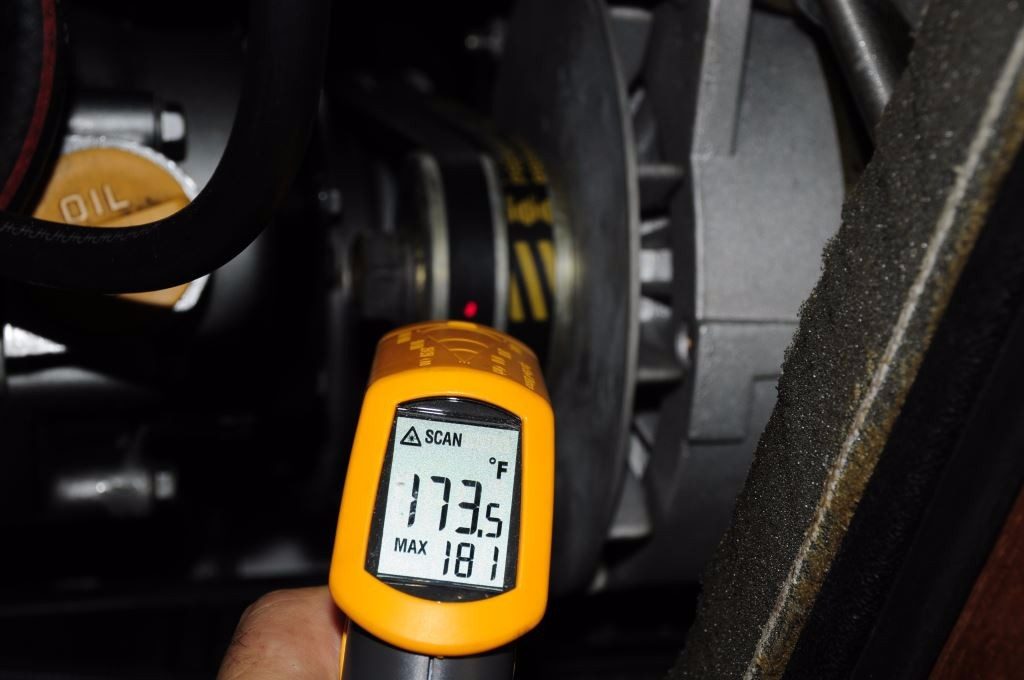
A properly selected and tensioned belt typically runs at roughly the same temperature as the engine’s coolant, between 175°F and 200°F.
Belt Types
The belts used to power these accessories are either the V variety, or the ribbon-shaped flat serpentine style. While V belts were the standard for decades, I clearly recall, as a young mechanic, the day when marine engine manufacturers first began emulating the automobile industry by adopting serpentine belts, it was truly exciting in a gearhead sort of way. From a mechanic’s and do it yourselfer’s perspective, serpentine belts are very attractive in that they are more robust and reliable, one belt is typically all that’s needed, they are far easier to replace; and most are self-tensioning.
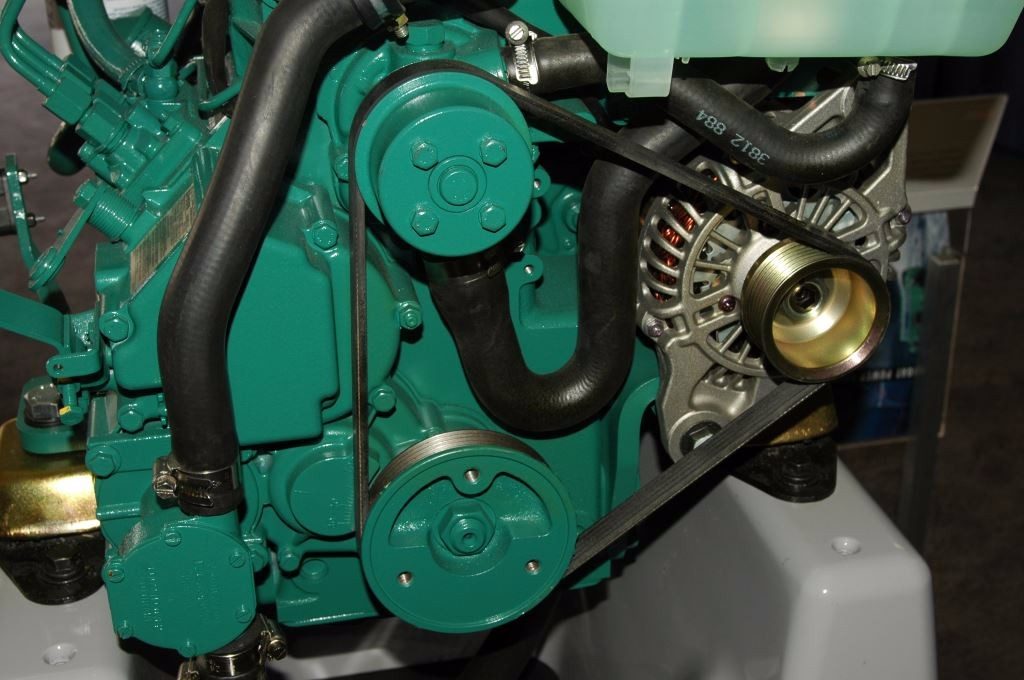
While most serpentine belt-equipped engines rely on an automatic tensioning device, some smaller models continue to utilize the alternator’s adjustment for tensioning purposes.
V belts, on the other hand, have their idiosyncrasies, often, multiple belts are needed, one may do double duty, sending power from the crankshaft pulley to both the alternator and circulator pump, while another belt may be used to turn a raw water pump. Generally speaking, unless a serpentine belt is used, conservative installations will resort to double V belts (for the most part matched belt sets are no longer used, as the manufacturing tolerances of higher quality belt manufacturers makes this unnecessary), when amperage exceeds 100 amps at 12 volts, or 50 amps at 24 volts.
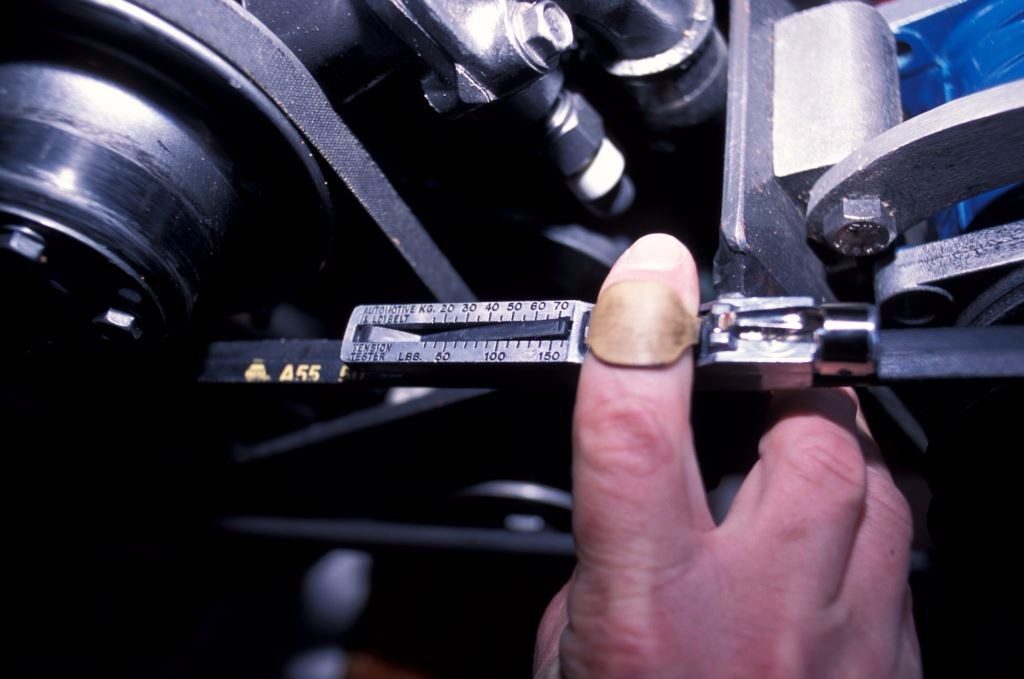
A Gates “Krikit” belt tension gauge, which enables users to apply proper tension to V belts.
Belt Service
Ordinary V belts are, with a little special knowledge, easily serviced, adjusted and replaced. “How tight should my belts be?” is almost certainly the most commonly asked question for those carrying out service and replacement. One dockside rule thumb calls for one half inch of belt deflection for every foot of belt span between pulleys, sometimes referred to as sheaves (rhymes with cheese). The problem with that approach is the deflection varies with the force that’s applied, and with no means of measuring that force the formula is of little use. Fortunately, a tool does exist for this application. Called the Kriket™, and made by Gates Rubber, it takes the guess work out of tensioning V belts. It’s readily available on line and at many auto parts stores, and is useful for both professionals and boat owners alike (I find pro’s tend to overtighten, while boat owners under tighten belts).
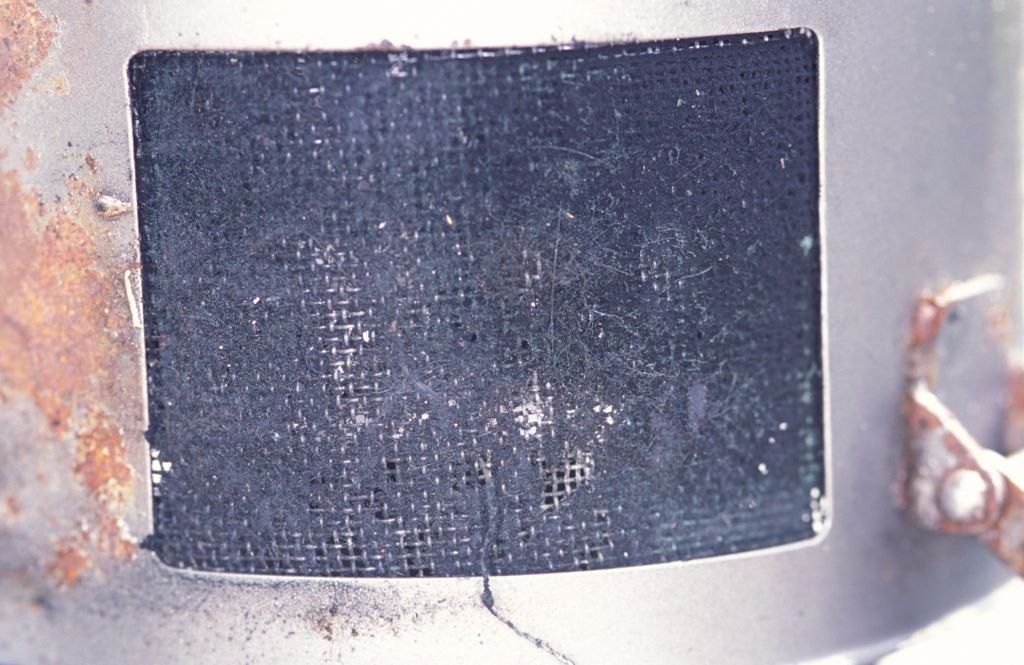
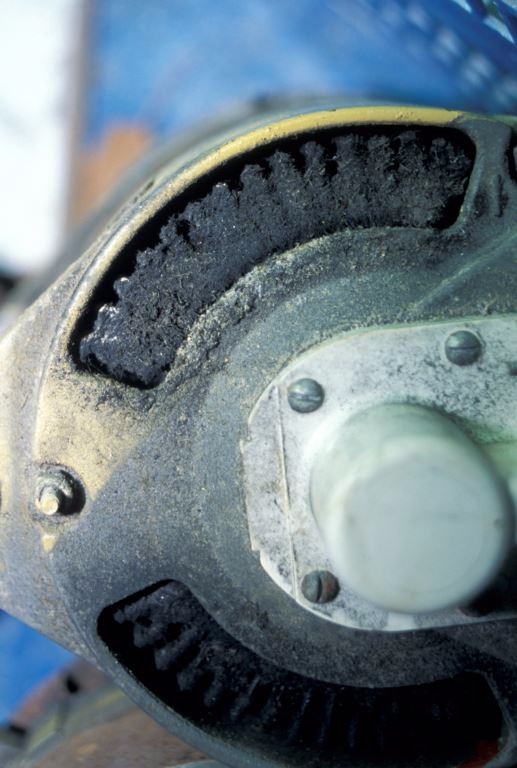
Belt dust, which is frequently generated by misaligned belts, is extremely fine. In addition to distributing itself over the front of the engine, it’s also drawn into the alternator, where it is deposited, and interferes with heat dissipation, as well as the engine’s air intake.
An under-tensioned belt will slip, and a slipping belt won’t turn its related accessories properly, it will overheat, wear out and break prematurely. An over-tensioned belt will accelerate wear on driven accessories’ bearings and seals. In addition to tension, alignment is another issue that must be dealt with. An accumulation of belt dust on the front of the engine or the alternator casing and fan, it’s often so fine and “greasy” that it’s mistaken for an oil leak, is nearly always an indication of a misaligned belt. Because it is so fine such dust is nearly always drawn into alternator windings, to which it adheres and hinders heat dissipation. Misalignment is a common occurrence in the case of after-market high output alternators, where support brackets are either improperly designed, or where they lack the necessary rigidity to prevent flexing and distortion when belts are tensioned.
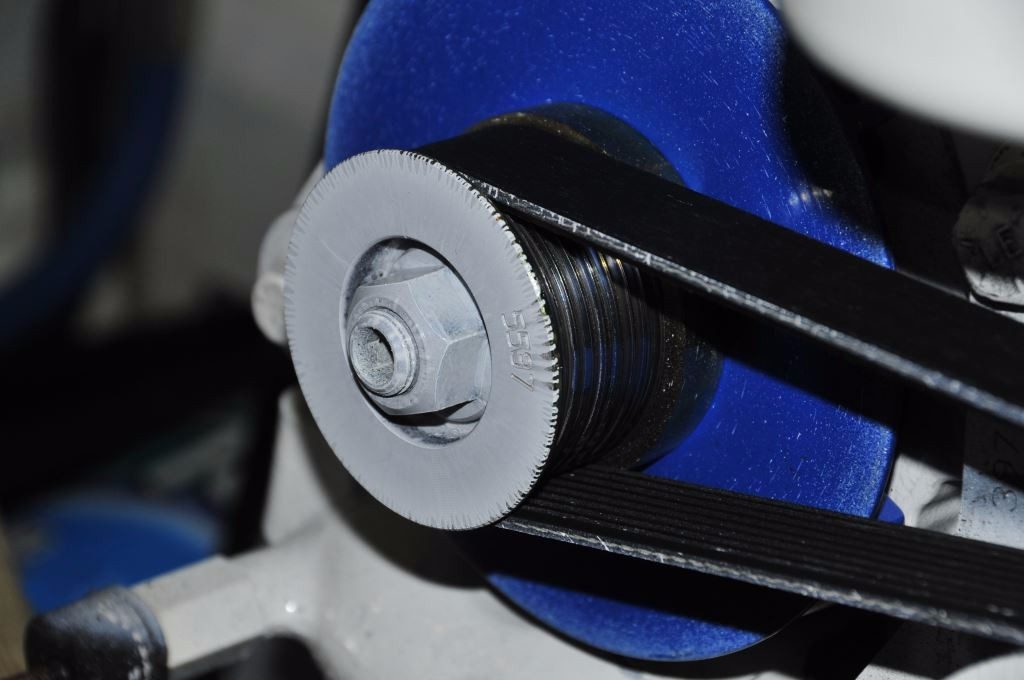
Belt engagement is critical, particularly on highly loaded components such as high output alternators. The rule of thumb for these is no less than 120°.
Shedding of belt chips, or chunks can be a sign of a heavily loaded belt that lacks sufficient pulley engagement or tension, which can cause the belt to skip; this is also especially common on high output alternator installations, where belts should engage pulleys for a minimum of 120°.
Loose belts, they create an unmistakable squeal, lead to glazing or polishing of the pulleys’ belt interface surfaces, overheating, and plasticization of the belt, all of which accelerate slippage. If the belt and/or pulley show signs of glazing, a particularly smooth, shiny, and in the case of the pulley an almost chrome-like appearance, it’s a clear indication the belt is slipping. A chronically slipping belt will lead to overheating of the pulley; in extreme cases it may turn purple, which in turn can damage an alternator; extreme heat will travel through the pulley shaft and into the rotor, upsetting the magnetic field, and preventing electricity from being produced.
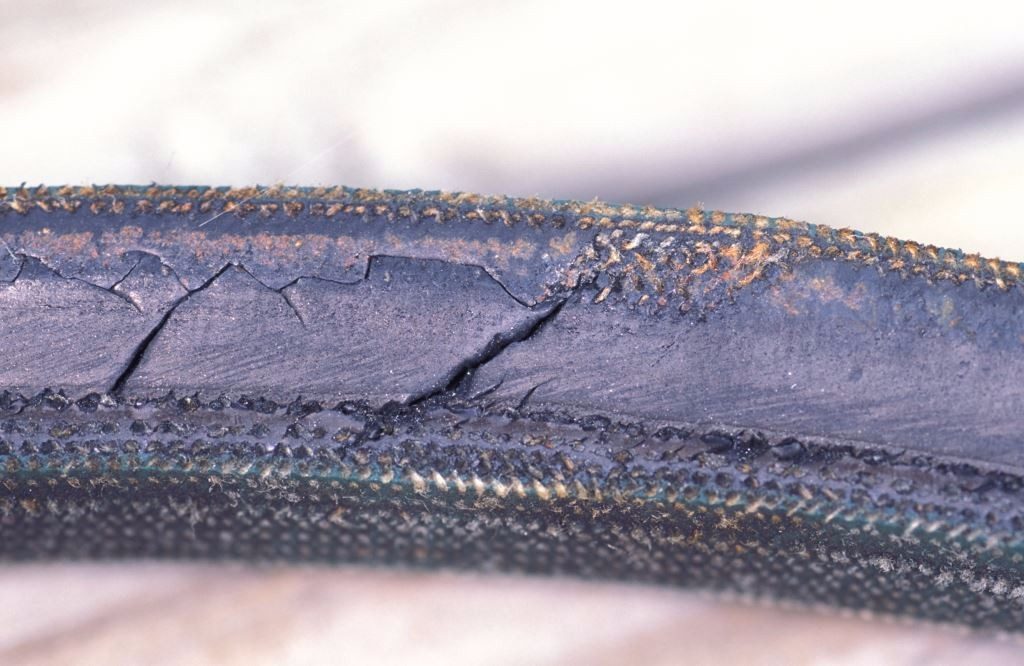
Slipping belts overheat rapidly, which leads to glazing and plasticization. Belts suffering from such damage must be replaced, and their pulleys carefully inspected for glazing. New belts installed on glazed pulleys will slip once again, and quickly suffer the same fate.
While an overheated, plasticized belt must be replaced; the glaze on a pulley can be removed using 220 grit Emory cloth, which is used to “dress” the glazed surface, returning it to a slightly rough, satin rather than high gloss finish. If a new belt is installed on a glazed pulley, it will almost certainly slip, recreating the original problem.
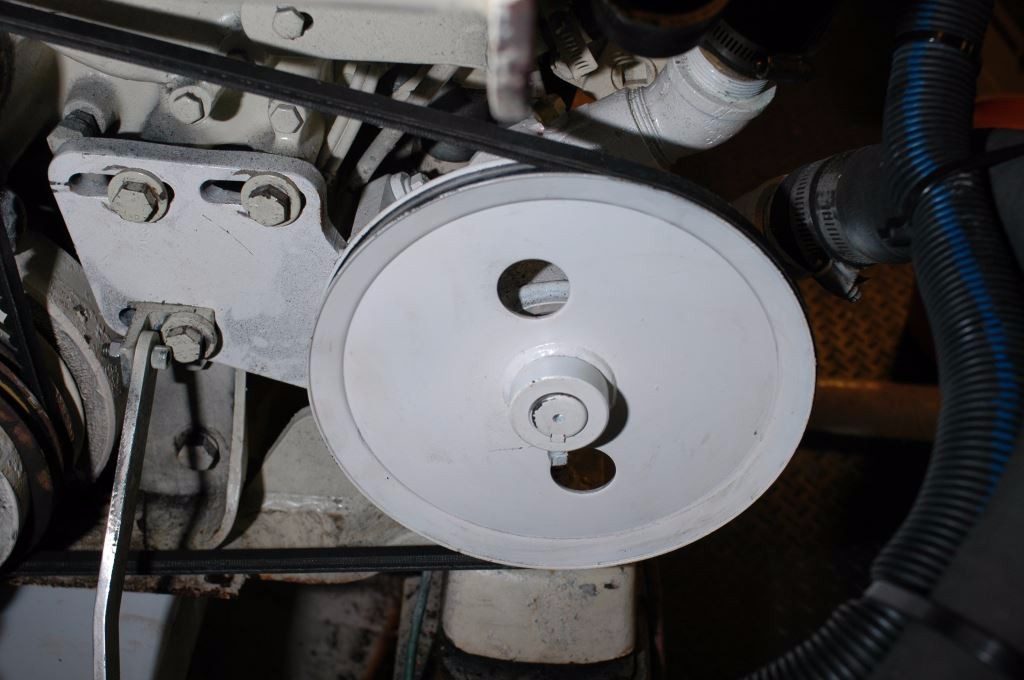
Large diameter pulleys engage the belt over considerable surface area, making slippage unlikely even when belts are under tensioned.
Where small diameter pulleys are used a notched V belt may be needed. Small pulleys are often used to increase alternator rpm on slow-turning diesel engines. Conventional belts can over heat as a result of rapid flexing associated with turning over these small diameter pulleys.
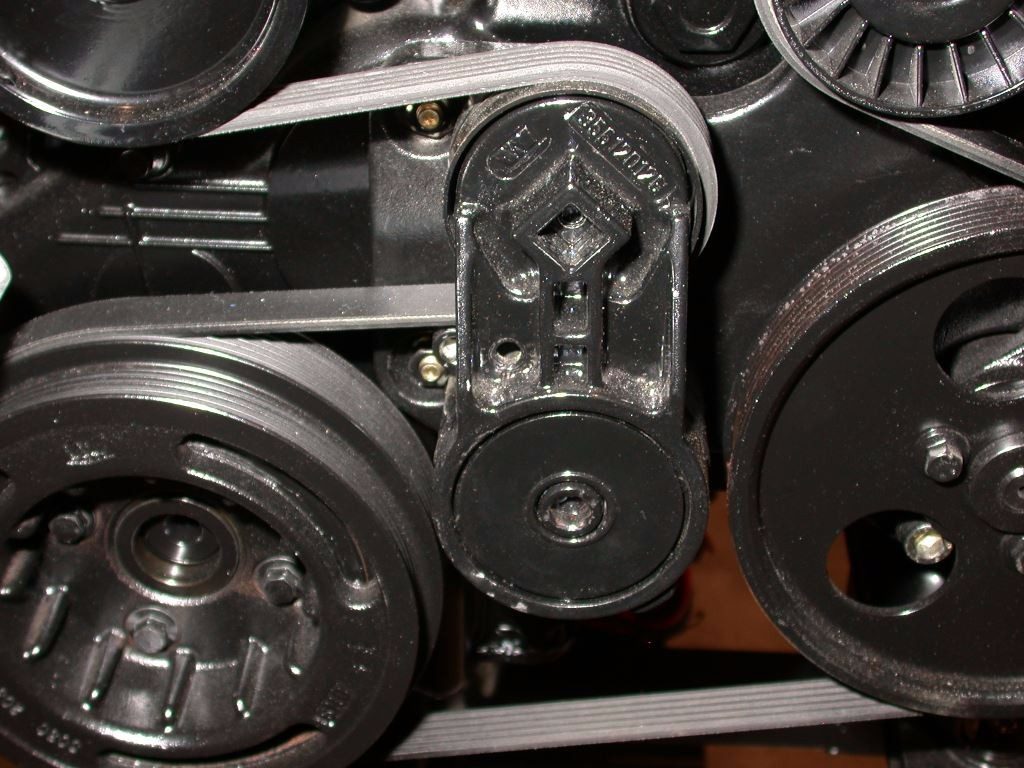
Many serpentine belt systems rely on an automatic or self-tensioning pulley. Most utilize a square recess, one can be seen here in the center of this image, into which a socket drive or breaker bar is inserted, which in turn is used to compress the spring for belt replacement.
With very few exceptions serpentine belts are self-tensioning, eliminating the most common cause of premature belt failures. A spring loaded tensioning pulley places just the right amount of pressure on the belt to keep it from slipping, while preventing over-tensioning. In order to replace a serpentine belt, however, the installer must have a means of compressing the considerable tension exerted by this device’s spring. This is often done by inserting a ½” drive socket wrench or breaker bar into a square recess in the tensioner’s arm and levering it into the compressed position (and holding it there while the belt is installed, some use a lanyard for this purpose, however, use caution, the spring tension is extremely high, never place your fingers between a belt and pulley). Without this tool it is virtually impossible to carry out a belt replacement. Additionally, unlike Most V belts, whose routing is intuitive, most serpentine belts take a circuitous, counter-intuitive path through and over accessory, idler and tensioning pulleys. Therefore, make certain you make a diagram or take a photo of the installed belt before the existing belt is removed or fails.
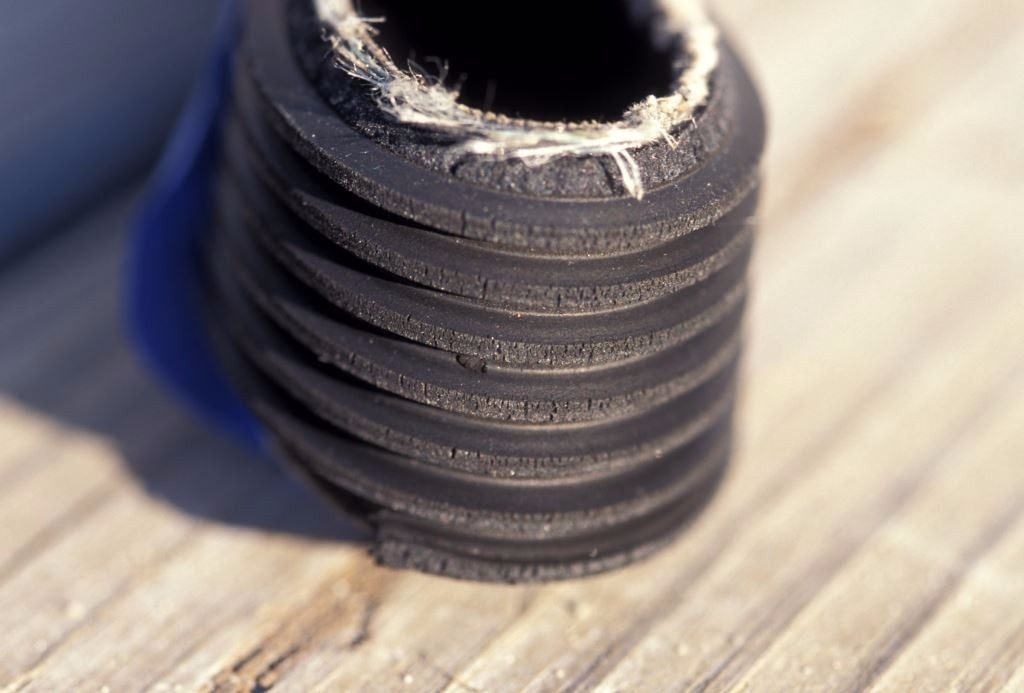
This serpentine belt is suffering from both wear and tear, as well as a worn tensioning pulley. The latter is evidenced by the white filament visible on this belt, the result of misalignment induced by the worn tensioner.
At each replacement, be sure to turn the idler pulleys, as well as the tensioning pulley, each should spin freely and smoothly, without excessive resistance, creaking or squeaking; any of the above call for replacement. A desirable belt replacement practice involves replacing all belts while dockside, under ideal conditions. Doing so will ensure you have the correct tools and belts. Once complete, save the old belts as spares, as you can be certain they fit. Many a skipper has been caught unprepared because a spare belt, even one supplied by the engine manufacturer, did not fit. Be sure to rotate your stock of spare belts and other rubber and soft goods, such as impellers, as these deteriorate storage.
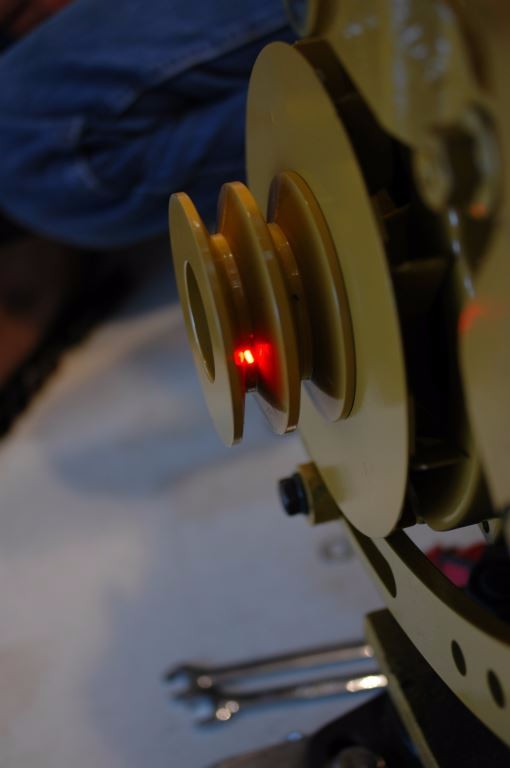
A laser is being used here to confirm proper belt alignment for this alternator, one of three on this engine.
For heavy duty applications, particularly high output alternators, and where maximum life is desired, consideration should be given to using extreme duty belts, both in the V and serpentine variety. Gates offers a range of belts called FleetRunner™ which are designed for use in ambulances, fire engines, military vehicles and other critical equipment. Identifiable by their unique green color, they are my belt of choice, and are well-suited for marine use.
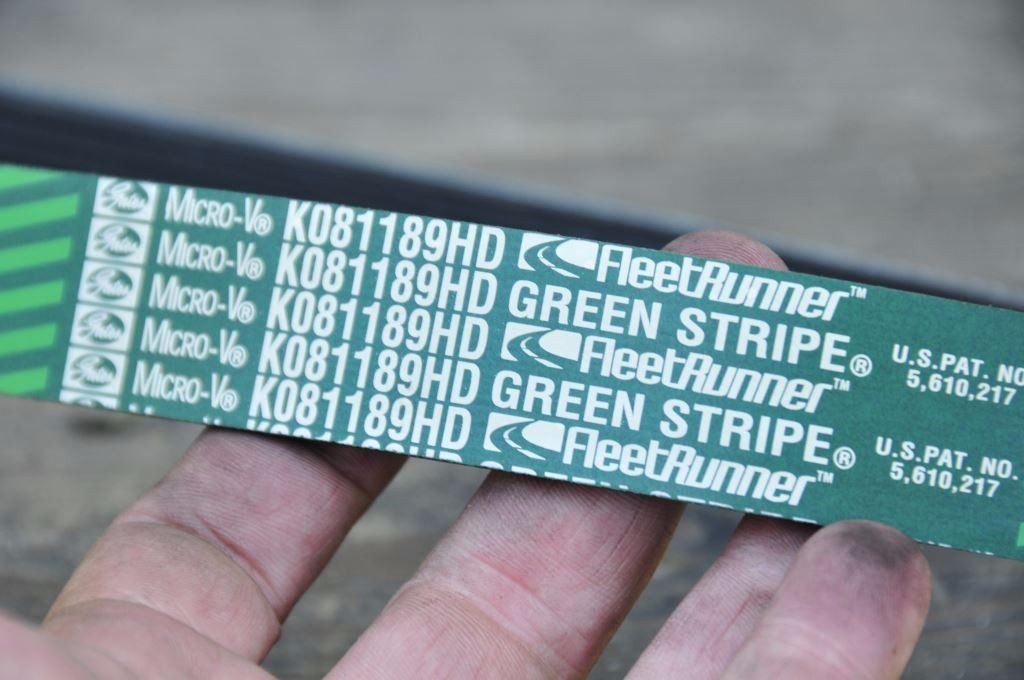
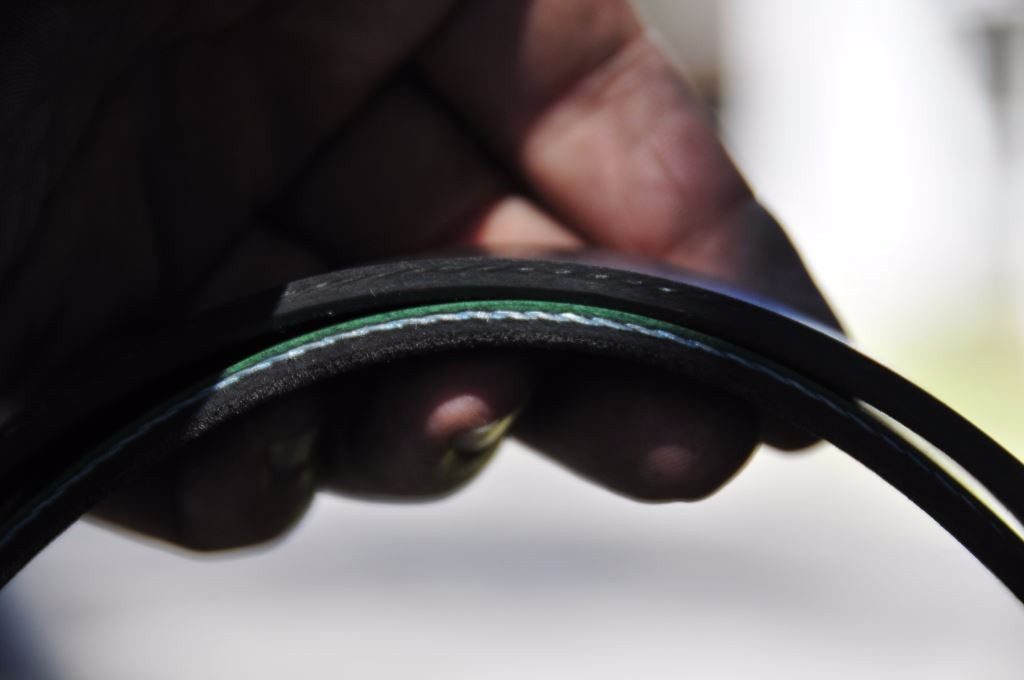
Demanding applications require heavy duty belts. The Gates FleetRunner series, available in both V and serpentine style, used on ambulances, emergency and military vehicles, is well suited to marine high output alternator applications. Compared to conventional belts, they are thicker and include additional reinforcement.
Belt Fit and Tensioning
Ensure that each V belt’s profile properly matches every pulley over which it turns. The belt should be even with or stand slightly proud, no more than a sixteenth of an inch, of the top of the pulley walls. Belt’s whose diameter is too large ride too high on the pulley groove walls, reducing the contact surface area, while belts that are too narrow ride in the bottom of the groove, causing them to teeter, reducing the tension on the groove walls.
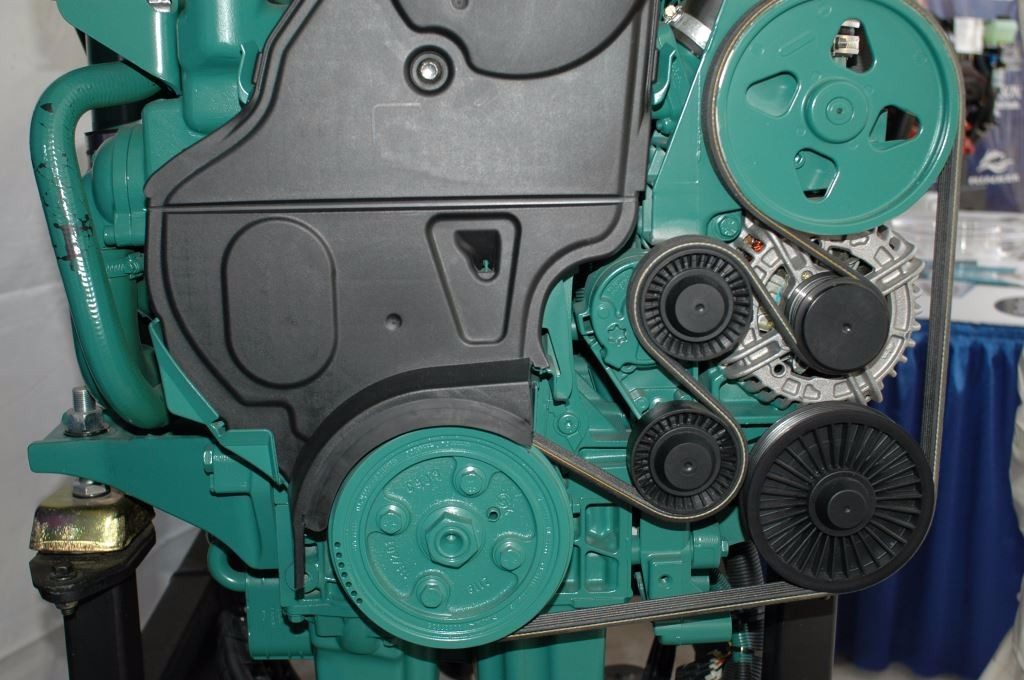
Serpentine belt routing is often anything but intuitive, be certain you have a diagram or photo of yours before undertaking replacement.
Serpentine belts come in different widths as well, typically measured by the number of grooves or ridges they possess, which must match those on the mating pulleys. Ideally, when fully tensioned, a V belt’s tensioning device, an alternator or pump, should be roughly in the middle of its adjustment range. Most serpentine belt tensioners are marked to indicate their allowable range of motion, which is a function of belt length. In a very few cases, some smaller serpentine belts used to drive a single device have neither an adjustment nor a self-tensioning wheel; instead the belt is designed to be “rolled” onto the pulley, allowing it to stretch and then retract into place. Make sure you know if your engine is equipped with one of these, and that you understand the replacement procedure.
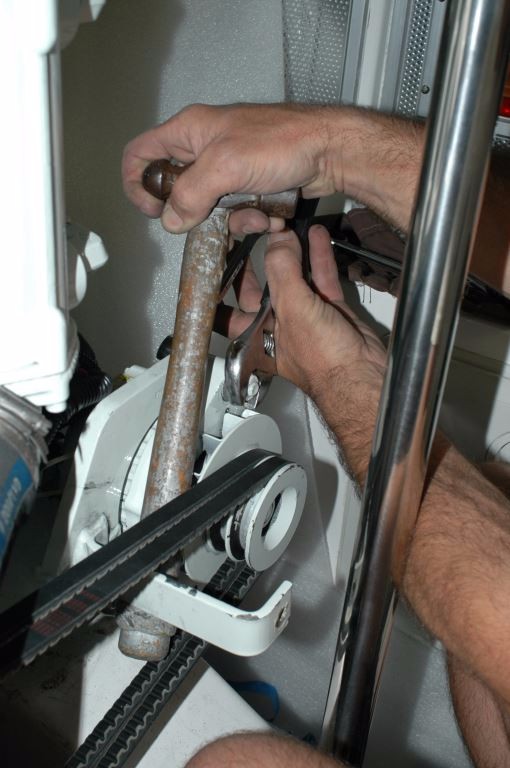
The handle of a hammer can be used to push an alternator or pump away from the crankshaft pulley, thereby tensioning the belt for adjustment.
To tension a V belt use a suitable prying mechanism, the handle of a hammer works well for small engines, while a crow bar may be needed for larger applications, as a lever to push the accessory away from the crankshaft pulley, and then tighten the fixing bolt. Threaded “spreader” bar tools are available to make this task easier, and some aftermarket high output alternator installations incorporate this into their design. Keep in mind, smaller driven pulleys (found on nearly all alternators) offer less belt contact area, making correct tension all the more critical; loads are high and slipping is a constant issue. Larger pulleys, on the other hand, like those used for many raw water pumps, offer more contact area, making tension less critical; loads are usually low and they rarely slip.
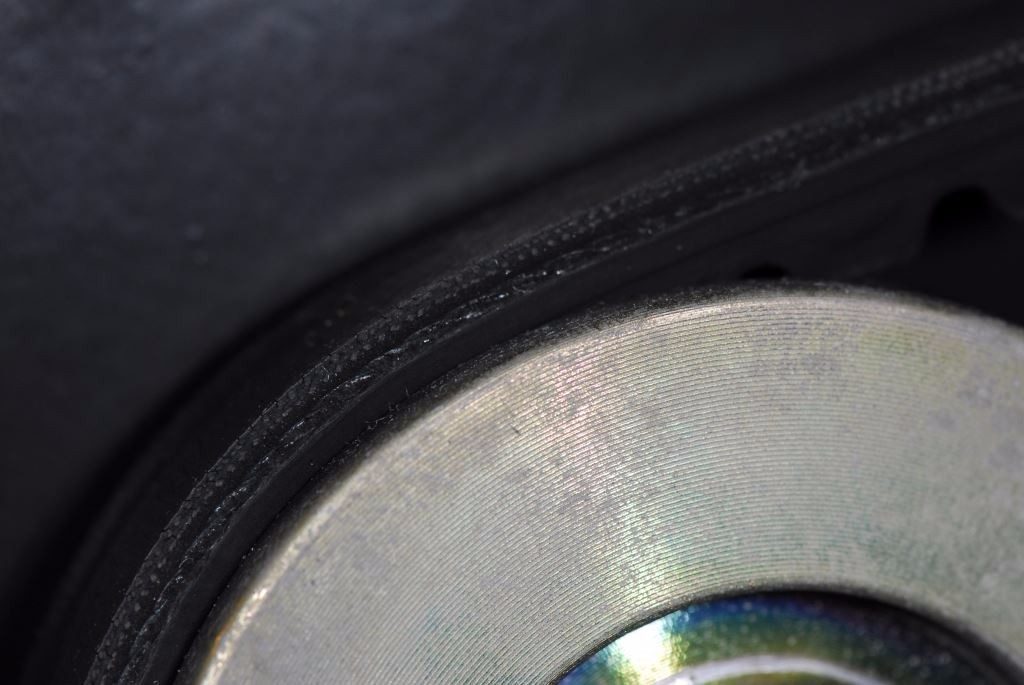
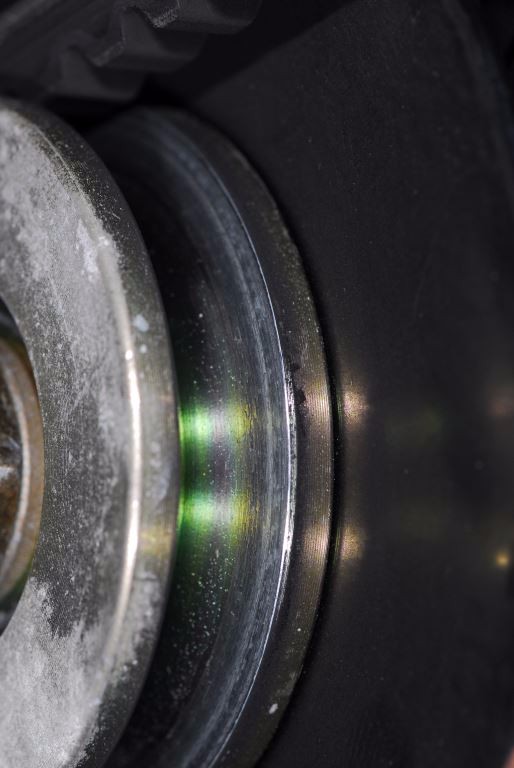
This belt is too wide for the pulley its driving, the belt stands substantially proud of the pulley, and it fails to make contact with most of the pulley wall, which can be seen by the wear pattern that is too high up the grove wall. Ideally, the wear pattern should be centered on the pulley wall.
Belts should be inspected regularly (don’t forget the ones hidden under belt guards and generator enclosures), look for evidence of glazing/slippage, guard interference, plasticization, cracking, dust production and improper tension. Where serpentine belts are concerned the appearance of belt filament, white threadlike material on one side of the belt, is often an indication of misalignment, which is typically the result of a worn tensioning pulley. As it wears, it tends to force the belt to one side of its own pulley and the downstream idler pulley, causing excessive wear. A squeal can also be associated with this phenomenon, as the belt is being “wiped” over a smooth, non-grooved idler pulley. When this occurs, many users simply change the belt, however, doing so will only yield a repeat performance; the problem can only be resolved permanently by replacing the tensioner.
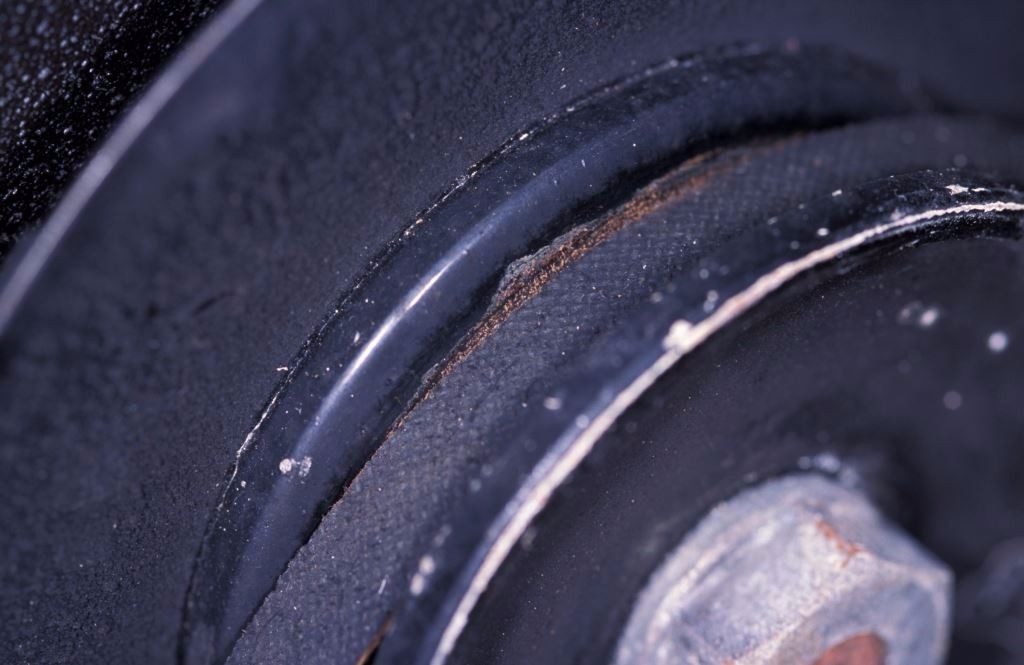
This belt is far too narrow for its pulley, it’s riding in the bottom of the groove, where contact is limited.
Belts are comparatively inexpensive, and thus it makes good sense to replace them every 2 years or 500 hours, whichever comes first. Remember, a new V belt may require adjustment and retensioning several times in the first 50-100 hours of use; watch for dust, glazing, squealing and chip shedding. For dust and chip shedding, be sure to clean up the fall out after making corrections, so you’ll know if the problem has been resolved.

